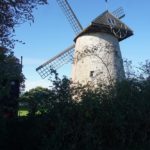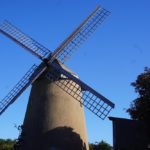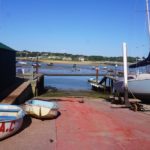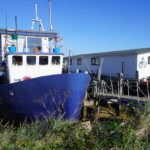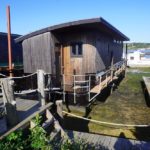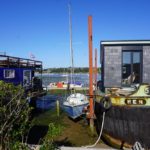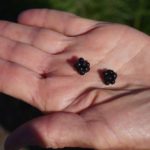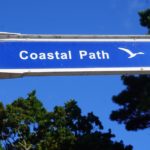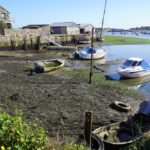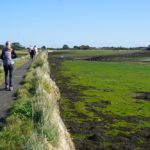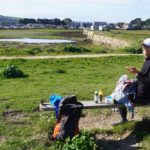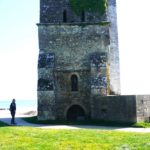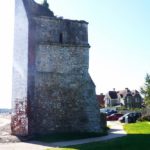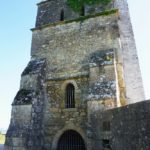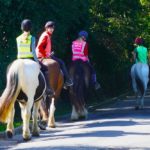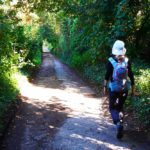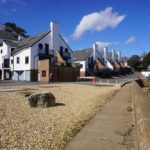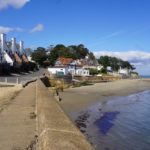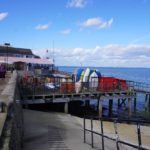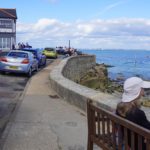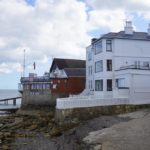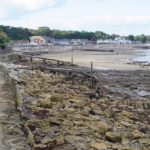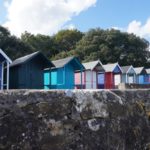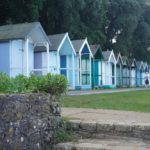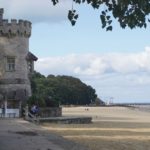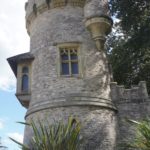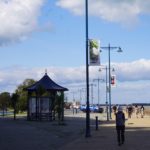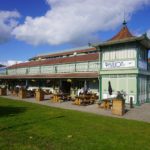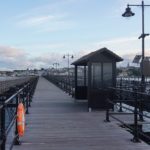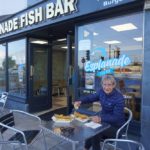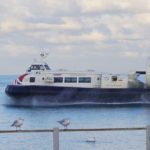Isle of Wight Day 2
We woke up this morning to probably the most perfect conditions on the whole trip. Min 9°, max 17°, no wind, no rain, bright sunshine. Ideal for a walk.
Our bus pass was good until 9.38am so we decided to use it to bus to Bembridge and walk back to Ryde. The buses ran at 40 min past the hour so the 9.40 was two minutes too late and we had to get the 8.40. Bembridge is the easternmost point of the island with quite a large tidal harbour. Getting off the bus there we walked about a kilometre inland to the Bembridge Mill. This is the only surviving mill on the Isle of Wight and was built in the early 1700s using local limestone. The weather side of the tower is faced with cement rendering. The whole wooden cap, complete with the windshaft, interior driving wheels, and the sweeps were turned to face into the wind. The mill was in continuous use until the 1890s grinding flour, bran and cattle feed. The mill ceased work in 1913 after which it decayed and became infested with deathwatch beetle. The mill was used as a cowshed and store until it was taken over by the Army and Home Guard in WWII and used as an observation post. In the 1950s it was gifted to the Island National Trust and restored.
From the mill we walked back down to Bembridge Harbour and joined the Coastal Path. Bembridge Harbour was empty of water, the tide being out and all the boats were sitting with their bottoms in the sand. There were many house boats some as large as a bungalow. It was from this harbour that Edward III set sail to invade Normandy in 1346, and it is said that this was the last port of call for Nelson and his crew en route to the Battle of Trafalgar in 1805. Part of the harbour was drained in 1358 creating mudflats and what is now a marshes nature reserve. There is a delightful stone causeway to walk across the mud flats. At the end of the causeway when you reach the coast again there is St Helen’s Old Church and the beach. The tower, that dates from 1220, is all that remains of a 13th century church. The church ceased to be used in 1703 when the tower was bricked up and used as a sea mark. The derelict church became a source of Holy Stones which were taken by sailors to scrub down the decks of wooden ships.
At this point the path went inland around a golf course and holiday park, through some woodland and along quiet farm lanes. It was here we had our last blackberries for this holiday. We have feasted on them everyday but now their season has all but ended. What were large and juicy were now small, hard and shrivelled.
The path came back to the sea shore at Seagrove Bay and we stayed on the coast all the way back to Ryde, sometimes on a promenade and sometimes on the beaches. The beaches were beautiful, protected bays of golden sand, ideal for swimming. On the way into Ryde we came upon Appley Tower, a folly built in 1875 in the form of a Tudor Revival circular tower with battlements, a turret, an oriel window facing the sea and Gothic Revival tracery windows. The estate to which the folly belonged has long gone.
It was a wonderful 12 km walk, ideal conditions, plenty of interesting highlights along the way, mostly flat, just a nice casual way to fill in a Saturday. When we got back to Ryde we had deserved an ice cream. We had seen The Esplanade Ice Cream Parlour advertising “Unicorn” flavour and as our granddaughter Ellie has a special liking for Unicorns we had one of those. This evening we walked to the end of the pier where the ferries leave from. The pier is very long, it took ten minutes to walk its length, and carries, vehicles, pedestrians and a train. This is where we will leave from tomorrow.
So what do we think of the Isle of Wight? Having been here all of two days and seeing about 10% of the island we are of course experts. It is also autumn and the summer peak is over, people are back at work and students are back at school. We really liked it. Interesting and low key with lots of lovely beaches. It is a great place for walking and we have a guide with 24 coastal and countryside walks. Some say it is stuck in the 1950s and it does feel a little like that. It was a very popular holiday destination until the English discovered cheap holidays abroad and the popularity of the Isle of Wight declined. It does seem to have an older population of residents and visitors (like us). 90% of the people on the buses we used were our age. A large number of visitors are older people seeking peace and quiet, and traditional food and attractions. There is none of the buzz and energy of say Paignton and Torquay where the beaches were full of young people and the towns full of dance clubs. The transport system is great, there is lots to see and do and all the kitsch and junk of a lot of tourism is not shoved in your face all day.
Like a circle in a spiral, like a wheel within a wheel
Never ending or beginning on an ever spinning reel
As the images unwind, like the circles that you find
In the windmills of your mind!
Songwriters: Alan Bergman / Marilyn Bergman / Michel Legrand
- Ryde Castle
- Bembridge Mill
- Bembridge Mill
- Bembridge Mill
- Bembridge Mill
- Bembridge Mill
- Bembridge Harbour
- Bembridge Harbour House Boats
- Bembridge Harbour House Boats
- Bembridge Harbour House Boats
- Bembridge Harbour House Boats
- Last blackberries Bembridge Bay
- Bembridge Bay, low tide
- Coastal Path sign Bembridge
- Bembridge Bay Harbour
- Bembridge Harbour Causeway
- Bembridge Harbour Causeway
- Bembridge Harbour Causeway
- St Helen’s Old Church
- St Helen’s Old Church
- St Helen’s Old Church
- Quiet country road St Helens
- Quiet farm road St Helens
- Seagrove Bay
- Seagrove Bay
- Seagrove Bay
- Seaview
- Seaview
- Seagrove Bay
- Tides Beach
- Beach Huts Springvale
- Beach Huts Springvale
- Appley Tower Appley Beach
- Appley Tower Appley Beach
- Appley Tower Appley Beach
- Ryde
- Ryde Pavilion
- Ryde Pier
- Ice Cream Ryde
- Unicorn ice cream Ryde
- Cod and chips Ryde
- Hovertravel Hovercraft


